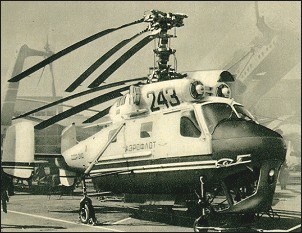
| Kamov Ka-25K 1968 - project |  |
 |

| Kamov Ka-25K 1968 - project |  |
 |
|
At its own initiative, the OKB made an attempt to build a civil derivative of the Ka-25 - the Ka-25K intended for cargo and passenger transportation and for flying crane operations. In 1967 the Ka-25K prototype was successfully demonstrated in the static display and in flight at the Le Bourget Air Show. The presentation of a co-axial helicopter - moreover, in such a "heavy" weight category - became an event quite out of the ordinary for the world aviation community, as the comments of helicopter design specialists testified. During refuelling stopovers on the way from Moscow to Paris and back the helicopter invariably became the centre of attention. The Ka-25K had an operator's cockpit suspended under the forward fuselage for controlling the machine during operations with slung loads. It could replace the remarkably versatile but obsolete piston-engined Mi-4 helicopter, production of which had ended in 1966. Suffice it to say that, having an identical take-off weight, the Ka-25K could transport a 2000kg load compared to 1300kg for the Mi-4. Design work on the Ka-25K was led by deputy chief designer I.A.Ehrlikh; the leading designer was S.V.Mikheyev. Yet, regrettably, this version of the helicopter did not enter service because of a Government decision to place an order in Poland for the design of the PZL W-3 "Sokyl" helicopter in the 6000-7000kg class. G.Kuznetsov "OKB Kamov - 50 years", 1999
A civil variant of the Ka-25, designated Ka-25K, was displayed at the Paris Air Show in 1967. Designed for use as a flying crane, it had a gondola under the nose (in place of the fairing for the search radar of the military version), with a rearward-facing pilot seat for controlling loading and unloading operations in the hover. A hatch was provided in the cabin floor for a cable to be lowered by winch. The cabin could take either a maximum load of 2000kg, 12 passengers or four stretchers and an attendant. This variant was not put into production or service. G.Apostolo "The Illustrated Encyclopedia of Helicopters", 1984 The Kamov Ka-25K (kran or crane) is a civil development of the Ka-25 military helicopter, which has the NATO reporting name Hormone. Like its military counterpart, the Ka-25K is based on a rotor system of two three-blade co-axial contra-rotating rotors on a tall mast. The Ka-25K has an extensively glazed gondola. This is unoccupied except during loading and unloading operations, when the second pilot lowers himself from the main cockpit into the rearward-facing seat in this chin gondola. Here he is ideally situated to command the aircraft with a second set of controls. The use of a co-axial rotor assembly eliminates the need for an anti-torque tail rotor, and keeps the overall dimensions of the helicopter as small as possible. In the case of the Ka-25K, the rotors, transmission and powerplant are mounted above the fuselage as a powerpack, and can be removed in only one hour. The engines, a pair of 900shp Glushenkov GTD-3 turboshafts, are mounted side-by- side forward of the transmission. Although intended primarily as a flying crane, the Ka-25K can also be used as a conventional transport helicopter. In this role the chin gondola is removed, and the load is accommodated in the large hold. The floor has nine lash-down points for freight, which can be loaded through a sliding door in the left side. Alternatively, up to 12 passengers can be carried on tip-up seats along the sides of the hold. For external loads, the freight sling is led through a hatch in the cabin floor. Bill Gunston "The Illustrated Encyclopedia of Commercial Aircraft", 1980 * * *
|